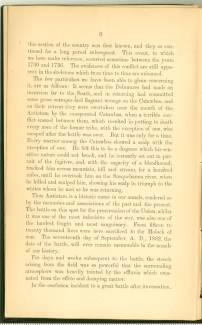Collection Name
About
this section of the country was first known, and they so continued for a long period subsequent. This event, to which we here make reference, occurred sometime between the years 1730 and 1736. The evidences of this conflict are still apparent in the skeletons which from time to time are exhumed.
The few particulars we have been able to glean concerning it, are as follows: It seems that the Delawares had made an incursion far to the South, and in returning had committed some gross outrages and flagrant wrongs on the Catawbas, and on their retreat they were overtaken near the mouth of the Antietam by the exasperated Catawbas, when a terrible conflict ensued between them, which resulted in putting to death every man of the former tribe, with the exception of one, who escaped after the battle was over. But it was only for a time. Every warrior among the Catawbas showed a scalp with the exception of one. He felt this to be a disgrace which his sensitive nature could not brook, and lie instantly Bet out in pursuit of the fugitive, and, with the sagacity of a bloodhound, tracked him across mountain, hill and stream, for a hundred miles, until he overtook him on the Susquehanna river, when he killed and scalped him, showing his scalp in triumph to the whites whom he met as he was returning.
Thus Antietam is a historic name in our annals, rendered so by the memories and associations of the past and the present. The battle on this spot for the preservation of the Union, whilst it was one of the most indecisive of the war, was also one of the hardest fought and most sanguinary. From fifteen to twenty thousand lives were here sacrificed to the Moloch of war. The seventeenth day of September, A. D., 1862, the date of the battle, will ever remain memorable in the annals of our history.
For days and weeks subsequent to the battle, the stench arising from the field was so powerful that the surrounding atmosphere was heavily tainted by the effluvia which emanated from the effete and decaying matter.
In the confusion incident to a great battle after its cessation,
